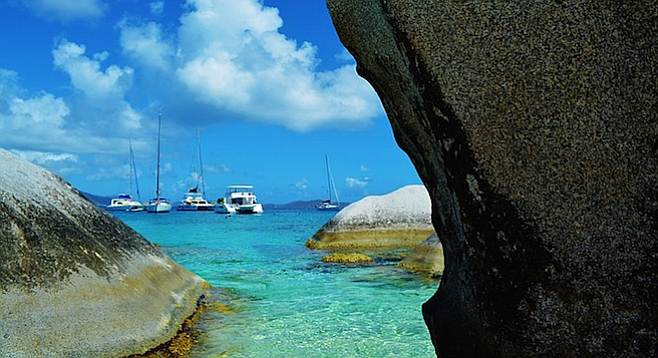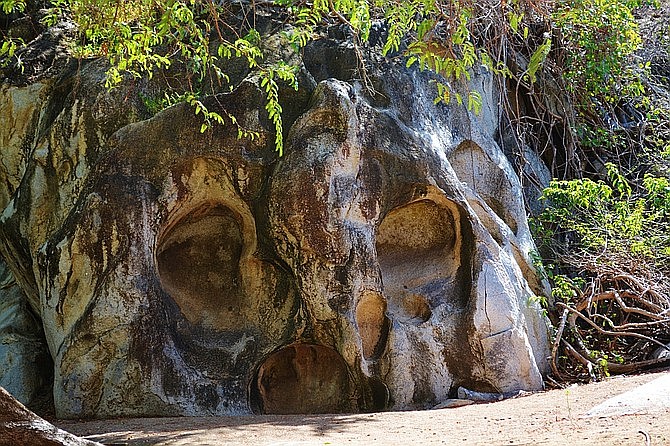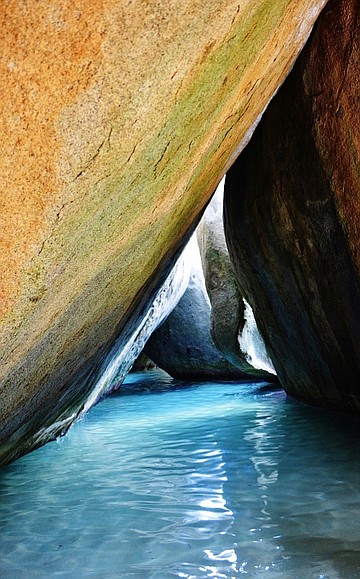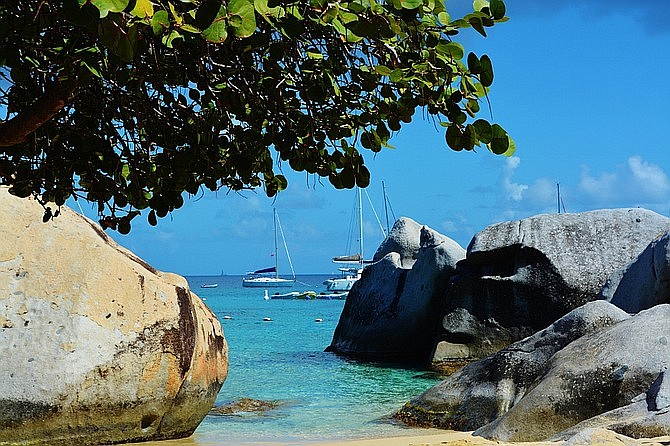 Facebook
Facebook
 X
X
 Instagram
Instagram
 TikTok
TikTok
 Youtube
Youtube

Framing the aquamarine Caribbean along a pristine, white sandy beach, the British Virgin Islands' Baths invariably evoke a jaw-dropping reaction from those visiting this feat of Mother Nature.
Located on the island of Virgin Gorda, the Baths (short for batholiths) comprise a labyrinth of massive granite boulders that create an array of cavernous passages through sheltered sea pools. The fascinating topography is the work of millions of years of geologic and geomorphic activity.
The batholiths were formed during the Tertiary period (65 million to 2.5 million years ago) by molten rock under immense pressure, seeping up into existing volcanic rock layers under a young Caribbean Sea.
Over time, the batholith reached sea level, as physical and chemical weathering rounded the sharp edges of these jumbled granite blocks.
Sailboats and stretches of palm-fringed beaches with sugar-white sand came into view as our small boat, on a day trip from St. Thomas, entered Spanish Town's Virgin Gorda Yacht Harbour.
Covering only eight square miles and sparsely inhabited, this third-largest of the Virgin Islands is a sleepy, idyllic Caribbean hideaway where goats and cattle own right of way over island traffic. The name – given to the island by Christopher Columbus – is Spanish for "Fat Virgin," because to these sea-weary mariners, the island's profile on the horizon somewhat resembled a voluptuous woman lying on her side. A 10- to 15-minute open-air taxi ride from the port transports visitors on a scenic, slightly uphill drive to the southwest entrance of Baths National Park.
From the park’s entrance, a winding path of hardened sand leads visitors downward through an arid, desert-like landscape lined with scrub vegetation and multi-hued and -shaped cacti.

An intriguing rock formation known as The Skull appears like a ghostly pirate sculpture – an eerie yet interesting example of the natural weathering that causes large dishes and holes that comprise the skull-like face.
Nothing prepares you as you leave the arid environment behind and face a magnificent wall of boulders- on a Caribbean beach. This enormous jumble of stone seems so out of place from the natural geology of these islands. A series of steps and rope handrails guide explorers through a maze of tunnels, arches and tidepools throughout the baths. Echoes of splashing water can be heard as explorers crawl through tight spaces and descend ladders. Every twist and turn yields yet another unbelievable site- hidden rooms with shafts of light streaming through, grottos which lead to more remarkable finds.

The Cathedral Room, a stunning display of geological formation, is the most photographed site inside the baths. Softly lit by rays of sunlight filtering down through small overhead gaps, its vertical rocks form an astonishing tall, deep, triangular shaped cavern. Admiring visitors pose in its shallows as warm sea water gently rushes in and out.
War journalist Martha Gellhorn visited Virgin Gorda in 1942 as part of a Caribbean tour to assess World War II’s impact on the region. She observed that on this peaceful isle even the concept of war seemed unreal. Gellhorn described it like this in her memoir, Travels With Myself and Another: “Giant boulders arranged by geologic upheaval eons ago create a scene that is both playful and spectacularly beautiful. The sound of waves, rustle of sea grape leaves, and brush of a gentle breeze – this is the sort of place that reminds me what a gift it is to be alive”.

As if the spectacle of the Bath’s cavernous beauty wasn’t enough, the spelunking trail exits to a picturesque clearing with views of horseshoe-shaped Devil’s Bay. Talcum-powdered sand is perfect for a rest from the hike under a shaded umbrella. Sailboats glide in and out of the calm bay, and seabirds soar in the skies overhead. Shallow clear waters and delightful coves are perfect for a relaxing swim.
Boulders strewn along the beach invite hikers to climb atop for even more astonishing views of the Baths. The crystalline waters of the bay teem with rays, blue tang and other tropical fish, inviting snorkelers and divers to explore more underground caves and coral reefs.
At the southern end of the beach, a trail leads to nearby Stoney Bay. Unlike Devil’s Bay, Stoney Bay’s windswept beaches face the crashing Atlantic that casts weathered driftwood along its rocky coastline.
Our sail back to St. Thomas took us past an archipelago of inlets, cays and islands, many uninhabited. Lush green mountains, miles of secluded pristine beaches. A quote by famous naturalist and preservationist John Muir came to mind. “When we contemplate the whole globe as one great dewdrop, striped and dotted with continents and islands, flying through space with other stars all singing and shining together as one, the whole universe appears as an infinite storm of beauty.” And what a day filled with beauty and adventure it was!
Check out the following site for more info on visiting: bvitourism.com/activity/baths-national-park.


Framing the aquamarine Caribbean along a pristine, white sandy beach, the British Virgin Islands' Baths invariably evoke a jaw-dropping reaction from those visiting this feat of Mother Nature.
Located on the island of Virgin Gorda, the Baths (short for batholiths) comprise a labyrinth of massive granite boulders that create an array of cavernous passages through sheltered sea pools. The fascinating topography is the work of millions of years of geologic and geomorphic activity.
The batholiths were formed during the Tertiary period (65 million to 2.5 million years ago) by molten rock under immense pressure, seeping up into existing volcanic rock layers under a young Caribbean Sea.
Over time, the batholith reached sea level, as physical and chemical weathering rounded the sharp edges of these jumbled granite blocks.
Sailboats and stretches of palm-fringed beaches with sugar-white sand came into view as our small boat, on a day trip from St. Thomas, entered Spanish Town's Virgin Gorda Yacht Harbour.
Covering only eight square miles and sparsely inhabited, this third-largest of the Virgin Islands is a sleepy, idyllic Caribbean hideaway where goats and cattle own right of way over island traffic. The name – given to the island by Christopher Columbus – is Spanish for "Fat Virgin," because to these sea-weary mariners, the island's profile on the horizon somewhat resembled a voluptuous woman lying on her side. A 10- to 15-minute open-air taxi ride from the port transports visitors on a scenic, slightly uphill drive to the southwest entrance of Baths National Park.
From the park’s entrance, a winding path of hardened sand leads visitors downward through an arid, desert-like landscape lined with scrub vegetation and multi-hued and -shaped cacti.

An intriguing rock formation known as The Skull appears like a ghostly pirate sculpture – an eerie yet interesting example of the natural weathering that causes large dishes and holes that comprise the skull-like face.
Nothing prepares you as you leave the arid environment behind and face a magnificent wall of boulders- on a Caribbean beach. This enormous jumble of stone seems so out of place from the natural geology of these islands. A series of steps and rope handrails guide explorers through a maze of tunnels, arches and tidepools throughout the baths. Echoes of splashing water can be heard as explorers crawl through tight spaces and descend ladders. Every twist and turn yields yet another unbelievable site- hidden rooms with shafts of light streaming through, grottos which lead to more remarkable finds.

The Cathedral Room, a stunning display of geological formation, is the most photographed site inside the baths. Softly lit by rays of sunlight filtering down through small overhead gaps, its vertical rocks form an astonishing tall, deep, triangular shaped cavern. Admiring visitors pose in its shallows as warm sea water gently rushes in and out.
War journalist Martha Gellhorn visited Virgin Gorda in 1942 as part of a Caribbean tour to assess World War II’s impact on the region. She observed that on this peaceful isle even the concept of war seemed unreal. Gellhorn described it like this in her memoir, Travels With Myself and Another: “Giant boulders arranged by geologic upheaval eons ago create a scene that is both playful and spectacularly beautiful. The sound of waves, rustle of sea grape leaves, and brush of a gentle breeze – this is the sort of place that reminds me what a gift it is to be alive”.

As if the spectacle of the Bath’s cavernous beauty wasn’t enough, the spelunking trail exits to a picturesque clearing with views of horseshoe-shaped Devil’s Bay. Talcum-powdered sand is perfect for a rest from the hike under a shaded umbrella. Sailboats glide in and out of the calm bay, and seabirds soar in the skies overhead. Shallow clear waters and delightful coves are perfect for a relaxing swim.
Boulders strewn along the beach invite hikers to climb atop for even more astonishing views of the Baths. The crystalline waters of the bay teem with rays, blue tang and other tropical fish, inviting snorkelers and divers to explore more underground caves and coral reefs.
At the southern end of the beach, a trail leads to nearby Stoney Bay. Unlike Devil’s Bay, Stoney Bay’s windswept beaches face the crashing Atlantic that casts weathered driftwood along its rocky coastline.
Our sail back to St. Thomas took us past an archipelago of inlets, cays and islands, many uninhabited. Lush green mountains, miles of secluded pristine beaches. A quote by famous naturalist and preservationist John Muir came to mind. “When we contemplate the whole globe as one great dewdrop, striped and dotted with continents and islands, flying through space with other stars all singing and shining together as one, the whole universe appears as an infinite storm of beauty.” And what a day filled with beauty and adventure it was!
Check out the following site for more info on visiting: bvitourism.com/activity/baths-national-park.
Comments